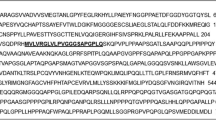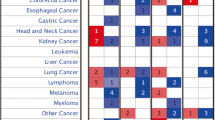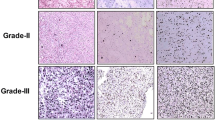Abstract
We have previously characterized three human leucine-rich repeats and immunoglobulin-like domains (LRIG) genes and proteins, named LRIG1-3 and proposed that they may act as suppressors of tumor growth. The LRIG1 transmembrane protein antagonizes the activity of epidermal growth factor receptor family receptor tyrosine kinases. In this study, we evaluated the mRNA expression level of LRIG1-3 in human glioma cell lines and control-matched glioma tissues, characterized the sub-cellular localization of an LRIG3–GFP fusion protein, and analyzed the relationship between sub-cellular localization of LRIG1-3 and clinical parameters in 404 astrocytic tumors by immunohistochemistry. LRIG1-3 mRNA was detected in all human glioma cell lines and matched glioma samples, with large differences in the expression levels. Ectopically expressed LRIG3–GFP localized to perinuclear and cytoplasmic compartments, and to the cell surface of transfected glioma cells. Perinuclear staining of LRIG1-3 was associated with low WHO grade and better survival of the patients. Perinuclear staining of LRIG3 was associated with a lower proliferation index and was in addition to tumor grade, an independent prognostic factor. Furthermore, within the groups of grade III and grade IV tumors, perinuclear staining of LRIG3 significantly correlated with better survival. These results indicate that expression and sub-cellular localization of LRIG1-3 might be of importance in the pathogenesis and prognosis of astrocytic tumors.






Similar content being viewed by others
References
Andersson U, Guo D, Malmer B, Bergenheim AT, Brannstrom T, Hedman H, Henriksson R (2004) Epidermal growth factor receptor family (EGFR, ErbB2-4) in gliomas and meningiomas. Acta Neuropathol 108:135–142
Cook PW, Piepkorn M, Clegg CH, Plowman GD, DeMay JM, Brown JR, Pittelkow MR (1997) Transgenic expression of the human amphiregulin gene induces a psoriasis-like phenotype. J Clin Invest 100:2286–2294
Dosaka N, Fujita M, Tanaka T, Miyachi Y, Imamura S (1989) Analysis of epidermal growth factor receptor gene in psoriasis. J Dermatol 16:184–186
Guo D, Holmlund C, Henriksson R, Hedman H (2004) The LRIG gene family has three vertebrate paralogs widely expressed in human and mouse tissues and a homolog in Ascidiacea. Genomics 84:157–165
Gur G, Rubin C, Katz M, Amit I, Citri A, Nilsson J, Amariglio N, Henriksson R, Rechavi G, Hedman H, Wides R, Yarden Y (2004) LRIG1 restricts growth factor signaling by enhancing receptor ubiquitylation and degradation. Embo J 23:3270–3281
Haapasalo H, Kylaniemi M, Paunul N, Kinnula VL, Soini Y (2003) Expression of antioxidant enzymes in astrocytic brain tumors. Brain Pathol 13:155–164
Hedman H, Nilsson J, Guo D, Henriksson R (2002) Is LRIG1 a tumour suppressor gene at chromosome 3p14.3? Acta Oncol 41:352–354
Holmlund C, Nilsson J, Guo D, Starefeldt A, Golovleva I, Henriksson R, Hedman H (2004) Characterization and tissue-specific expression of human LRIG2. Gene 332:35–43
Ichimura K, Ohgaki H, Kleihues P, Collins VP (2004) Molecular pathogenesis of astrocytic tumours. J Neurooncol 70:137–160
Kleihues P, Cavenee WK (2000) WHO Classification of tumours pathology and genetics of tumours of nervous system. IARC Press, Lyon
Knuutila S, Aalto Y, Autio K, Bjorkqvist AM, El-Rifai W, Hemmer S, Huhta T, Kettunen E, Kiuru-Kuhlefelt S, Larramendy ML, Lushnikova T, Monni O, Pere H, Tapper J, Tarkkanen M, Varis A, Wasenius VM, Wolf M, Zhu Y (1999) DNA copy number losses in human neoplasms. Am J Pathol 155:683–694
Laederich MB, Funes-Duran M, Yen L, Ingalla E, Wu X, Carraway KL 3rd, Sweeney C (2004) The leucine-rich repeat protein LRIG1 is a negative regulator of ErbB family receptor tyrosine kinases. J Biol Chem 279:47050–47056
Mischel PS, Shai R, Shi T, Horvath S, Lu KV, Choe G, Seligson D, Kremen TJ, Palotie A, Liau LM, Cloughesy TF, Nelson SF (2003) Identification of molecular subtypes of glioblastoma by gene expression profiling. Oncogene 22:2361–2373
Nash MA, Deavers MT, Freedman RS (2002) The expression of decorin in human ovarian tumors. Clin Cancer Res 8:1754–1760
Nilsson J, Vallbo C, Guo D, Golovleva I, Hallberg B, Henriksson R, Hedman H (2001) Cloning, characterization, and expression of human LIG1. Biochem Biophys Res Commun 284:1155–1161
Nilsson J, Starefeldt A, Henriksson R, Hedman H (2003) LRIG1 protein in human cells and tissues. Cell Tissue Res 312:65–71
Paquet ME, Cohen-Doyle M, Shore GC, Williams DB (2004) Bap29/31 influences the intracellular traffic of MHC class I molecules. J Immunol 172:7548–7555
Ranuncolo SM, Varela M, Morandi A, Lastiri J, Christiansen S, Bal de Kier Joffe E, Pallotta MG, Puricelli L (2004) Prognostic value of Mdm2, p53 and p16 in patients with astrocytomas. J Neurooncol 68:113–121
Reifenberger G, Ichimura K, Reifenberger J, Elkahloun AG, Meltzer PS, Collins VP (1996) Refined mapping of 12q13-q15 amplicons in human malignant gliomas suggests CDK4/SAS and MDM2 as independent amplification targets. Cancer Res 56:5141–5145
Ribom D, Andrae J, Frielingsdorf M, Hartman M, Nister M, Smits A (2002) Prognostic value of platelet derived growth factor alpha receptor expression in grade 2 astrocytomas and oligoastrocytomas. J Neurol Neurosurg Psychiatr 72:782–787
Sandilands E, Cans C, Fincham VJ, Brunton VG, Mellor H, Prendergast GC, Norman JC, Superti-Furga G, Frame MC (2004) RhoB and actin polymerization coordinate Src activation with endosome-mediated delivery to the membrane. Dev Cell 7:855–869
Schamel WW, Kuppig S, Becker B, Gimborn K, Hauri HP, Reth M (2003) A high-molecular-weight complex of membrane proteins BAP29/BAP31 is involved in the retention of membrane-bound IgD in the endoplasmic reticulum. Proc Natl Acad Sci USA 100:9861–9866
Suzuki Y, Sato N, Tohyama M, Wanaka A, Takagi T (1996) cDNA cloning of a novel membrane glycoprotein that is expressed specifically in glial cells in the mouse brain. LIG-1, a protein with leucine-rich repeats and immunoglobulin-like domains. J Biol Chem 271:22522–22527
Suzuki Y, Miura H, Tanemura A, Kobayashi K, Kondoh G, Sano S, Ozawa K, Inui S, Nakata A, Takagi T, Tohyama M, Yoshikawa K, Itami S (2002) Targeted disruption of LIG-1 gene results in psoriasiform epidermal hyperplasia. FEBS Lett 521:67–71
Tanemura A, Nagasawa T, Inui S, Itami S (2005) LRIG-1 provides a novel prognostic predictor in squamous cell carcinoma of the skin: immunohistochemical analysis for 38 cases. Dermatol Surg 31:423–430
Thomasson M, Hedman H, Guo D, Ljungberg B, Henriksson R (2003) LRIG1 and epidermal growth factor receptor in renal cell carcinoma: a quantitative RT–PCR and immunohistochemical analysis. Br J Cancer 89:1285–1289
Varela M, Ranuncolo SM, Morand A, Lastiri J, De Kier Joffe EB, Puricelli LI, Pallotta MG (2004) EGF-R and PDGF-R, but not bcl-2, overexpression predict overall survival in patients with low-grade astrocytomas. J Surg Oncol 86:34–40
Wojcik C, Schroeter D, Wilk S, Lamprecht J, Paweletz N (1996) Ubiquitin-mediated proteolysis centers in HeLa cells: indication from studies of an inhibitor of the chymotrypsin-like activity of the proteasome. Eur J Cell Biol 71:311–318
Acknowledgements
This study was supported by grants from The National Cancer Foundation and Lion’s Cancer Research Foundation, Umeå University, Sweden. Kerstin Bergh is acknowledged for her excellent assistance with the immunohistochemical staining. We also thank Björn Tavelin for statistical advice.
Author information
Authors and Affiliations
Corresponding author
Rights and permissions
About this article
Cite this article
Guo, D., Nilsson, J., Haapasalo, H. et al. Perinuclear leucine-rich repeats and immunoglobulin-like domain proteins (LRIG1-3) as prognostic indicators in astrocytic tumors. Acta Neuropathol 111, 238–246 (2006). https://doi.org/10.1007/s00401-006-0032-5
Received:
Revised:
Accepted:
Published:
Issue Date:
DOI: https://doi.org/10.1007/s00401-006-0032-5




